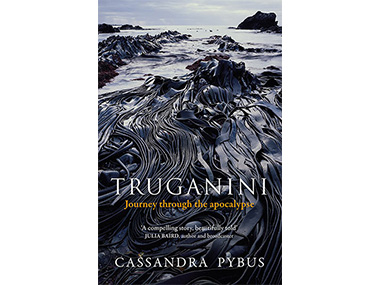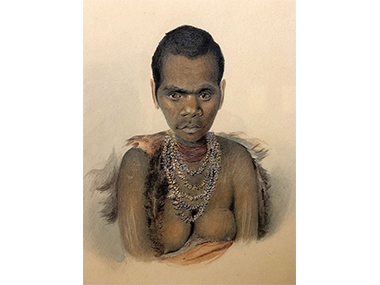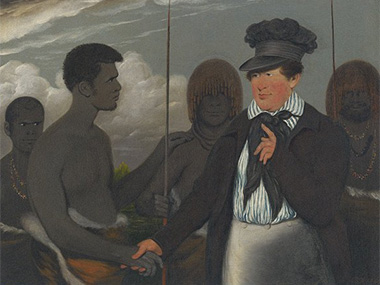'Truganini – Journey Through the Apocalypse'

The threatened bull kelp of Tasmania reflects the dark and twisted history in this book
Jeremy Eccles | 14.05.20
Author: Jeremy Eccles
News source: Review
“In doleful monochrome, they seemed so desolate I couldn't bear to look at them. It was a melancholic requiem for the disappeared that reeked of regret without responsibility”.
Author Cassandra Pybus is describing photographs of “the last Tasmanians” in Hobart's Museum. But she might as well be describing the doleful effect her book, 'Truganini – Journey Through the Apocalypse' had upon me in the reading. Pybus may have approached her eponymous subject with the honourable intent of discovering “how she lived, not simply that she died”. For Pybus was conscious that as a Tasmanian herself, her ancestors had actually engaged with the Nuenonne woman on Bruny Island and heedlessly taken her land. But over and above biography, she's ripped a veil off a quite conscious and callous genocide of the people of the nine Tasmanian native nations – extirpation was the favoured word at the time in a Tasmania still called Van Dieman's Land – which makes it hard to allow me to think I'd revisit that soiled island any time again soon.
It's such a powerful a book, I ended up demanding to know just who were these fellow-members of my race – from “upright citizens” like Governor Arthur and Richard Pybus to the syphilitic bounty-hunter, John Batman and the surprising number of freelance whalers and sealers operating way outside colonial limits, who would forcibly breed future generations of Tasmanian Aborigines by abducting the tribes' wives and daughters. And why did these people seem so different from the 'pioneers' on the mainland – or were they just the same?
Bruce Pascoe's 'Convincing Ground' – his more aggressive precursor to 'Dark Emu' – suggests that Batman's Port Phillip (soon to be Victoria) was little different to Tasmania in its colonising style. But then he also suggests that George Augustus Robinson – GAR - Chief Protector of Aborigines in Port Phillip after his Custodian exploits in Tasmania, was “thought to be Truganini's lover”. Pybus is convinced otherwise, despite the pair's 6 years in close reciprocity bringing in the last doomed clansmen from across the length and breadth of VDL. For Truganini, it seems, was so sexually active from the age of about 16, with convict woodcutters and sealers as often as her own clansmen, that she carried a venereal disease, which, amazingly, never killed her in a 74-year long life.
Was this promiscuity the norm in Tasmanian Aboriginal society? Pybus tentatively puts this widespread lack of discrimination by its women down to the operation of the captive's Stockholm Syndrome. But this may be part of the author's proper reluctance to impute ideas and words to the island's Indigenes. And this means that a book called 'Truganini' is, in fact, a study of the more easily understood George Augustus Robinson, based on the three volumes of his Journals. And Truganini – or Trugernanna as GAR refers to her; or even Trucanini as the 2018 National Gallery historical exhibition about the art of the Black War, 'The National Picture' decided was the closest to the Nuenonne pronunciation – disappears from those journals when he goes to the Australian mainland, despite his insistence on her and her husband Wooredy accompanying him.
And if that name strikes a chord, can I remind you of Mudrooroo's 1983 book, 'Doctor Wooreddy's Prescription for Enduring the End of the World', which covers much the same catastrophe as Pybus's book in what some may consider a more appropriately apocalyptic manner. For the Tasmanian clans' Raegewarrah seems to have been a pre-existing word to describe just such an apocalypse as the invaders were meeting out upon them, though it was also amongst Truganini's last words as she fell into a coma. “Raegewarrah catch me”, she cried after an amazing life negotiating between the squalid behaviour and lies of GAR and his ilk and remnant peoples of a tribal life that had once been so close to perfect.
As Pybus puts it, Truganini and her lifelong friend Dray were able to leave the miserable, almost derelict former convict prison at Oyster Cove where they'd ended up, slip across the d'Entrecasteaux Channel to their beloved Bruny Island, throw off their hated colonial clothes, and sit naked on a beach eating the oysters and abalone they were so adept at catching, and “throwing the shells over their shoulders just as their families had done in that lost world of only 40 years earlier”.
Historically, it was only at this point in 1876 that Truganini came into her own. For all previous references to her, apart from GAR's, were to her as someone's husband – and she did have four. But her death, the last full-blood Tasmanian who'd stood in the way of good, white civilisation, was both symbolic and a huge relief.
As Bernard Smith in his 1980 Boyer Lecture entitled, 'The Spectre of Truganini' put it: “Since 1788 Aborigines have been treated in their own country as if they were sub-human. But I do not propose to dwell upon atrocities. Truganini's story must stand for all those that will never be written, but live on in the folk memories of the descendants of the victims. By contrast, white Australians have tried to forget”. And Smith was discussing Clive Turnbull's 1948 book, 'Black War : The Extermination of the Tasmanian Aborigines'.
This is not a new story! It had taken a century to have Truganini's skeleton removed from display in both Melbourne and Hobart, casts of it traded to museums around the world, and to cremate her properly, scattering her ashes as she'd requested in the d'Entrecasteaux Channel. There at last she was free from the hands of men who'd despoiled her in life.
And what of GAR? This self-serving, self-deluding builder who attempted to jump across the class barriers that Britain had exported to its colony by 'saving the blacks' and bringing them to Christianity on a distant Bass Strait island, who lied that they would be returned to their Country after the Black War was over, and then saw them die like flies of measles and flu hastened by grief, did in the end, Pybus believes, come to acknowledge his own culpability in his journals. 'They are the lawful owners, not us”, he admitted.
One of his victims, the northeastern Nation's leader Mannalargenna, simply cut off his ochre and fat-larded curly locks, lay down and died on his Flinders Island place of exile. Only an (unnamed) Chief Justice opposed this heartless exile, proposing a treaty and a protected area of the mainland for them. For he feared that a nomadic people “might pine and die there”, which would be “a terrible stain on the honour of the British Empire”. He was ignored. Not surprising when the surgeon William Lodewyk Crowther spent more time grave-robbing and sending Aboriginal skulls off to the UK than curing people, but went on to become Premier of this benighted island.
Small wonder that today, a 2-metre tall rock petroglyph rock carving that once formed part of a 20-kilometre network of carvings that gave insight into stories, totems, warriors, camps and roads spanning thousands of years languishes in that same Hobart Museum despite the wishes of the Aboriginal Land Council of Tasmania to bring it back to its west coast Country. It had been sawn off in the 1960s.
'Truganini – Journey Through the Apocalypse' by Cassandra Pybus is published by Allen & Unwin at $33.
URL: https://www.allenandunwin.com/browse/books/other-books/Truganini-Cassandra-Pybus-9781760529222
Share this:
»  del.icio.us
»
del.icio.us
»  Digg it
»
Digg it
»  reddit
»
reddit
»  Google
»
Google
»  StumbleUpon
»
StumbleUpon
»  Technorati
»
Technorati
»  Facebook
Facebook
Contact Details

'Truggernana'/Truganini – as a young and desirable woman, painted by Thomas Bock in 1831. The portrait was only recently identified by Tasmanian Aboriginal curator, Gaye Sculthorpe at the British Museum.

George Augustus Robinson, GAR himself in his rather camp “bush outfit”, painted by Benjamin Duterrau. Mudrooroo would later describe GAR as “that splendidly comic character, the self-appointed missionary and spiritual redeemer".
Further Research
News Tags: Bruce Pascoe | Cassandra Pybus | Gaye Sculthorpe | George Augustus Robinson | Jeremy Eccles | John Batman | Mudrooroo | Truganini | Woodredy
News Archive
- 28.04.21 | CANBERRA
- 23.04.21 | Sydney Biennale - 'From a Brook to a River'
- 22.04.21 | 2021 Telstra NATSIAA Finalists Announced
- 15.04.21 | National Aboriginal Art Gallery Gets a Boss
- 29.03.21 | THE NATIONAL 2021
- 26.03.21 | TRUTH-TELLING
- 24.03.21 | All Revealed in Freo
- 22.03.21 | Bla Mela Kantri
- 19.03.21 | Two Big Moves
- 16.03.21 | The Very Late Charlie Flannigan
- 08.03.21 | PAPUNYA ART AT 50
- 05.03.21 | ANTEDILUVIAN ROO
- 19.02.21 | National Endowment for Indigenous Visual Arts
- 19.02.21 | lutruwita apology
- 17.02.21 | SONGSPIRALS TWIST AROUND SONGLINES
Advertising

